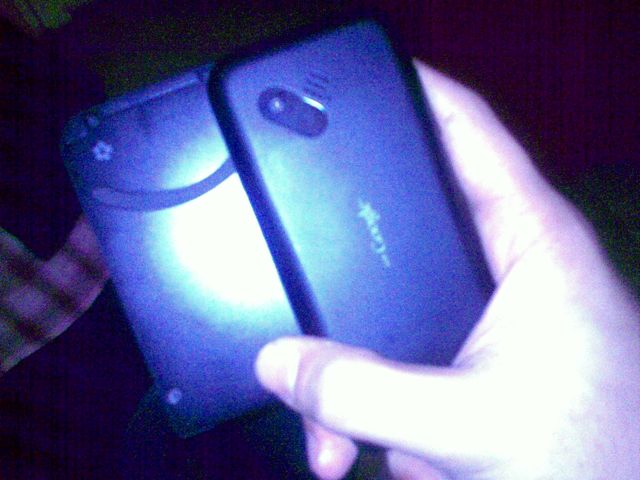Pardon me for the ugly photos. We were in low light and I didn’t have a decent camera to take photos. Then again, the blurry shots give some sort of “OMG you really held one!” aura. Heh.
So Art “no rice” Samaniego (inside joke, folks! 🙂 ) calls this the “Ugly Betty” of the mobile phone industry. It is by far the most interesting piece of technology since the iPhone because it is the first implementation of Google’s Android OS. So it is indeed curious, and thanks to Art I was able to take a few shots of the G1, which was manufactured by HTC.
More photos and extensive first impressions after the jump.
Design
Although HTC is now known for their elegant Touch series of devices, the G1 is very disappointing in terms of aesthetics. Compare this side by side an iPhone, a Nokia E71 or a Palm Treo and the G1 definitely stands out as the least elegant. In fact, if you’ve ever held a BenQ P50 or P51, the G1 feels like a spiritual successor in terms of the way it cradles onto your hand. I must reiterate, it does look cheap.
The design of the G1 is highlighted by the odd slider mechanism that snaps the screen in and out, revealing or hiding the QWERTY keypad. Although unique, the mechanism snaps in and out with so much force, it may cause you to drop the device if you’re not careful. You’re going to be doing a lot of opening and closing as this is the default way to input text. Sliding the keypad out automatically brings you to landscape view.
Usability
If you’re curious to compare the scroll quality of the G1 (powered by Android) and the iPhone / iPod touch, I made a short video demo below. It’s very similar:
The UI philosophy behind the G1 is very different from the iPod touch / iPhone as the former is limited to three side scrolls and a taskbar which you can pull up at any time. The three menus contain apps, displayable widgets (like Google Chrome, you can convert apps into shortcuts or widgets onto the main menu), and a search bar. The taskbar displays all the apps you’ve installed. Widgets can be dragged around the screen by simply pressing and holding and then dragging them around.
Perhaps the biggest winner for Android is the Android Apps store. This is very similar to the Apple iTunes / Apps Store with the exception that there aren’t much restrictions to application approvals. This allows developers more freedom, yet it can also cloud the store with a lot of useless applications. But as stated in the book, The Wisdom of Crowds, the community will eventually self monitor content, with the more useful applications standing out.
Features
The G1’s 3.1MP camera isn’t something worth writing home about. Here’s a sample photo taken with it, resized to 600 x 400 for easy viewing. I took out the flash.
Other features include Bluetooth, 802.11g WiFi, and GPS navigation. What’s also disappointing with the G1 is that you cannot beam photos via Bluetooth. You need to send them via GMail.
The G1’s browser is very decent. Although the device is touch screen enabled, you cannot perform the pinching functions similar to the iPhone.
Bottomline
Art asked me to rate the device based on my first impressions. I have to agree with him that we should wait for the “G2” or whatever HTC comes up with for T-Mobile. Apart from the odd sliding keyboard, the G1’s body is also slightly curved. The built in scroll wheel in the middle of the device is a good addition, but it would have been to T-Mobile’s benefit if they made the device look a little more elegant.
However, in terms of what’s inside the device, the G1 is a software masterpiece, as it is the only device that truly matches the iPhone’s usability without compromising it’s own set of neat features. I honestly can’t wait to see how Android develops in the next few months.
Afterthought
The exciting thing about G1 is that this is the proof of concept of Android – a Linux based operating system that aims to cut cost in production because it is free. Because it is supported by an open community, the user experience becomes more sensitive in terms of making adjustments. What’s even more promising is that phone manufacturers are already placing their bet on an Android device. Not only will this cut cost, but it will also enable big phone manufacturers to customize Android to fit their hardware. Imagine a Nokia or Samsung or Sony Ericsson phone running on Android with an iPhone like experience? And this definitely will not hurt their pervious investments (Nokia for instance has S60) because since Android is an open platform, it will be relatively easy* to create applications or conduits to sync data to and from their proprietary operating systems (like Symbian, Windows Mobile, BlackBerry etc).
* Nota Bene: this is merely an assumption based on what information we’re given, but it seems very possible and probable.






Leave a Reply